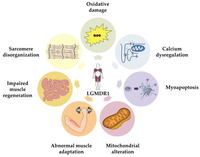Muscular Dystrophy, Limb-Girdle, Autosomal Dominant 4

A number sign (#) is used with this entry because of evidence that autosomal dominant limb-girdle muscular dystrophy-4 (LGMDD4) is caused by heterozygous mutation in the CAPN3 gene (114240) on chromosome 15q15.
Biallelic mutation in the CAPN3 gene can cause autosomal recessive limb-girdle muscular dystrophy-1 (LGMDR1; 253600), which has earlier onset and is in general a more severe disorder.
DescriptionAutosomal dominant limb-girdle muscular dystrophy-4 is characterized by onset of proximal muscle weakness in young adulthood. Affected individuals often have gait difficulties; some may have upper limb involvement. Other features include variably increased serum creatine kinase, myalgia, and back pain. The severity and expressivity of the disorder is highly variable, even within families (summary by Vissing et al., 2016).
For a discussion of genetic heterogeneity of autosomal dominant limb-girdle muscular dystrophy, see 603511.
NomenclatureAt the 229th ENMC international workshop, Straub et al. (2018) reviewed, reclassified, and/or renamed forms of LGMD. The proposed naming formula was 'LGMD, inheritance (R or D), order of discovery (number), affected protein.' Under this formula, LGMD1I was renamed LGMDD4.
Clinical FeaturesVissing et al. (2016) reported 37 individuals from 10 unrelated families of northern European descent with limb-girdle muscular dystrophy. The phenotype and severity were highly variable, even within families. Most patients had symptom onset as adults (average 34 years), although a few patients had onset in the first or second decade. Features included proximal muscle weakness and atrophy of the upper and lower limbs. Most patients remained ambulatory, but 3 were wheelchair-bound. Patients had a common pattern of muscle involvement, including the paraspinal, gluteal, hamstring, and medial gastrocnemius, which was confirmed by fatty replacement of muscle tissue in these muscles on imaging. Serum creatine kinase was elevated in most, but not all, patients, and muscle biopsy, when performed, showed myopathic changes, including increased internal nuclei, variation in fiber size, and occasional fibrosis. Additional features included back pain and myalgia. Overall, the disorder was similar to LGMDR1, but was less severe. Several mutation carriers were clinically asymptomatic, but showed subtle signs of the disorder, such as increased serum creatine kinase or muscle atrophy.
Martinez-Thompson et al. (2018) reported 3 families of northern European descent with autosomal dominant limb-girdle muscular dystrophy. Two of the families were multigenerational and very large. Clinical features of the 3 probands were described in detail. The patients had onset of proximal muscle weakness mainly affecting the lower limbs between 20 and 50 years of age. They had back pain, hyperlordosis, myalgia, and gait abnormalities due to proximal muscle weakness. Other features included scapular winging and weakness of the abdominal wall. Physical examination and/or imaging showed atrophy and fatty replacement of the iliopsoas, gluteus, and paraspinal muscles. EMG studies showed a myopathic pattern, and patients had variably increased serum creatine kinase. Muscle biopsy showed mild chronic myopathic changes, such as fiber splitting, some internal nuclei, type 1 fiber predominance, and rare regenerating fibers.
InheritanceThe transmission pattern of limb-girdle muscular dystrophy in the families reported by Vissing et al. (2016) was consistent with autosomal dominant inheritance.
Molecular GeneticsIn 36 patients from 10 families of northern European descent with autosomal dominant limb-girdle muscular dystrophy type 1I, Vissing et al. (2016) identified a heterozygous in-frame 21-bp deletion (c.643_663del21) in the CAPN3 gene (114240.0011). The families were identified from several different neuromuscular centers in northern Europe. Haplotype analysis of 4 families indicated a founder effect. Analysis of several patients' muscle tissue showed normal mRNA levels and no evidence of nonsense-mediated mRNA decay, but significantly decreased CAPN3 protein levels, at less than 15% of control values. Vissing et al. (2016) postulated that the in-frame nature of the mutation may have led to expression of a mutated protein which could have a dominant-negative effect.
In 3 unrelated patients of northern European descent with LGMDD4, Martinez-Thompson et al. (2018) identified the same heterozygous 21-bp deletion in the CAPN3 gene that had been reported by Vissing et al. (2016). The deletion resulted in the deletion of residues Ser215_Gly221 in the first structural domain. The mutations were found by next-generation, whole-exome, or Sanger sequencing; all were confirmed by Sanger sequencing. Each proband had a family history of the disorder, although not all affected family members were available for genetic testing. Functional studies of the variant were not performed, but Western blot analysis of patient tissues showed greatly decreased amounts of the CAPN3 protein.